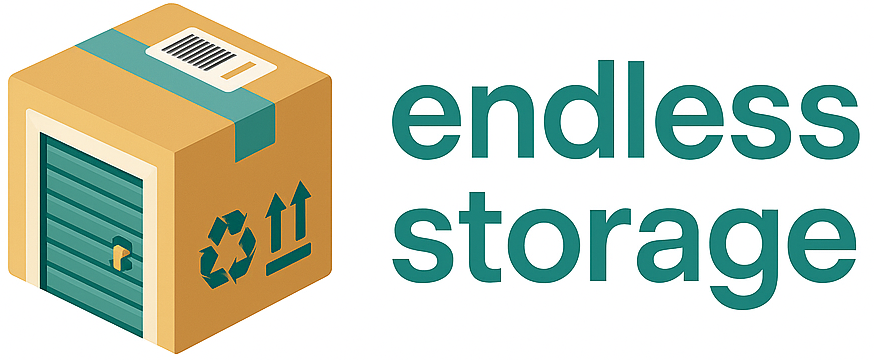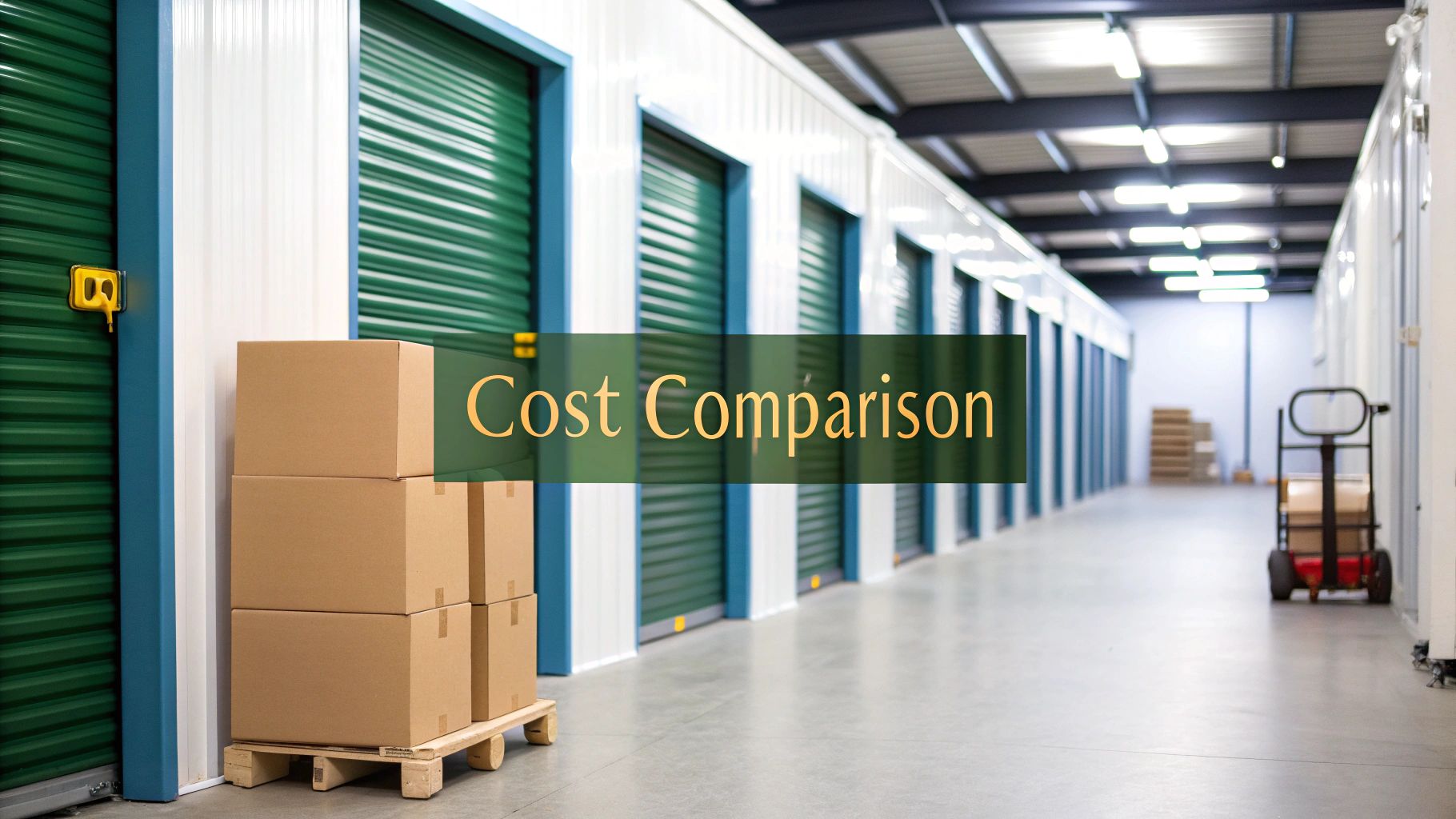When you start looking into a storage unit cost comparison, you quickly learn one thing: the price tag isn't always what it seems. While the national average might sit around $89 per month, that number can be deceptive. The final bill you pay is shaped by a lot more than just the advertised rate.
Understanding Current Storage Unit Costs
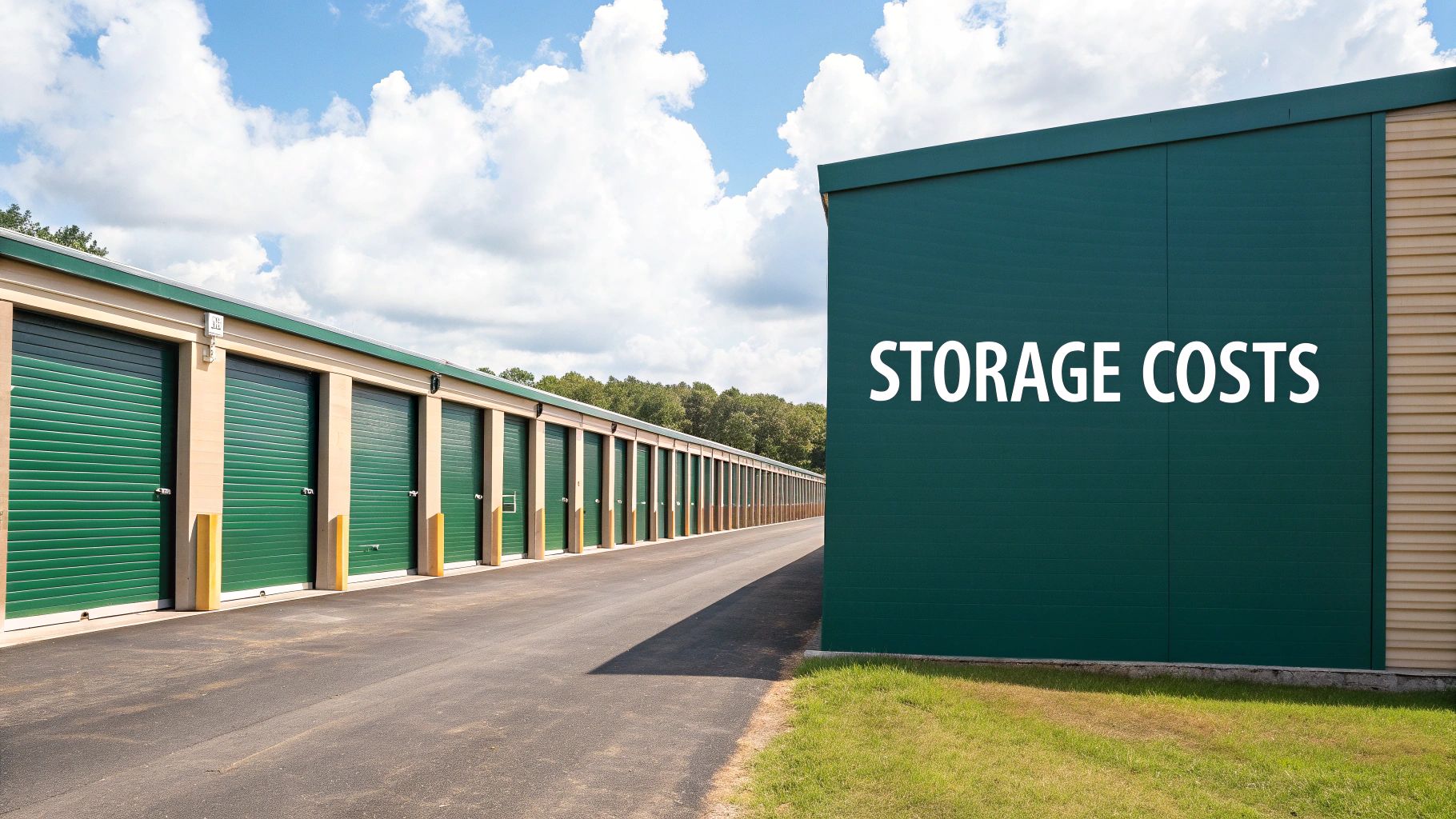
Before you even start comparing companies, it helps to get a feel for the market itself. The price you're quoted for a storage unit is a direct reflection of local real estate values, how much demand there is, and what kind of amenities the facility offers. Getting a handle on these key drivers will help you find a storage solution that gives you real value, not just a low introductory price.
Geographic Price Differences
Location is hands-down the biggest factor when it comes to storage unit costs. It’s simple economics: a unit in a crowded city center will almost always cost you more than the exact same size unit out in the suburbs or a rural area. This all comes down to higher property values, taxes, and the general cost of doing business in major cities.
The data backs this up. In 2025, the average self-storage unit in the U.S. cost about $89.12 per month, which works out to be $0.91 per square foot. That price represents a 4% jump since 2021, mostly because demand has been so high. Some major West Coast cities like Los Angeles and Seattle saw costs shoot up by 7% to 10% in 2022 alone. Meanwhile, cities in the Midwest and South saw a more modest increase of 2% to 4%.
Key Takeaway: You'd be surprised what a difference a short drive makes. Going just 15-20 minutes outside of a major metro area can often save you a significant amount of money. Sometimes you can even snag a larger unit for the same price as a smaller one in the city.
The Impact of Unit Size and Features
It goes without saying that the size of the unit is a major part of the cost—the more space you need, the more you'll pay. A small 5x5 unit, which is about the size of a walk-in closet, is your most budget-friendly option. On the other end, a large 10x20 unit that can hold everything from a multi-bedroom house will be at the top of the price range. To make sure you're not paying for space you don't need, it’s worth checking out our guide on choosing the right storage unit size.
Beyond just square footage, certain features will add a premium to your monthly rent. These aren't just fancy extras; they can be critical for protecting specific types of belongings.
- Climate Control: This is a big one. It keeps the temperature and humidity inside your unit stable, which is crucial for protecting sensitive items like wood furniture, electronics, artwork, or important documents from warping, mildew, or heat damage. You can expect to pay anywhere from $20 to $50 more per month for this peace of mind.
- Drive-Up Access: If you’re storing heavy furniture or bulky boxes, a unit with drive-up access is a lifesaver. Being able to pull your car or truck right up to the door makes loading and unloading so much easier, but this convenience often costs a little more than an indoor unit of the same size.
- Enhanced Security: Facilities that go the extra mile with security—think individual unit alarms, extensive video surveillance, and on-site managers—will often factor the cost of these protections into their pricing.
Choosing the Right Storage Unit Size and Type
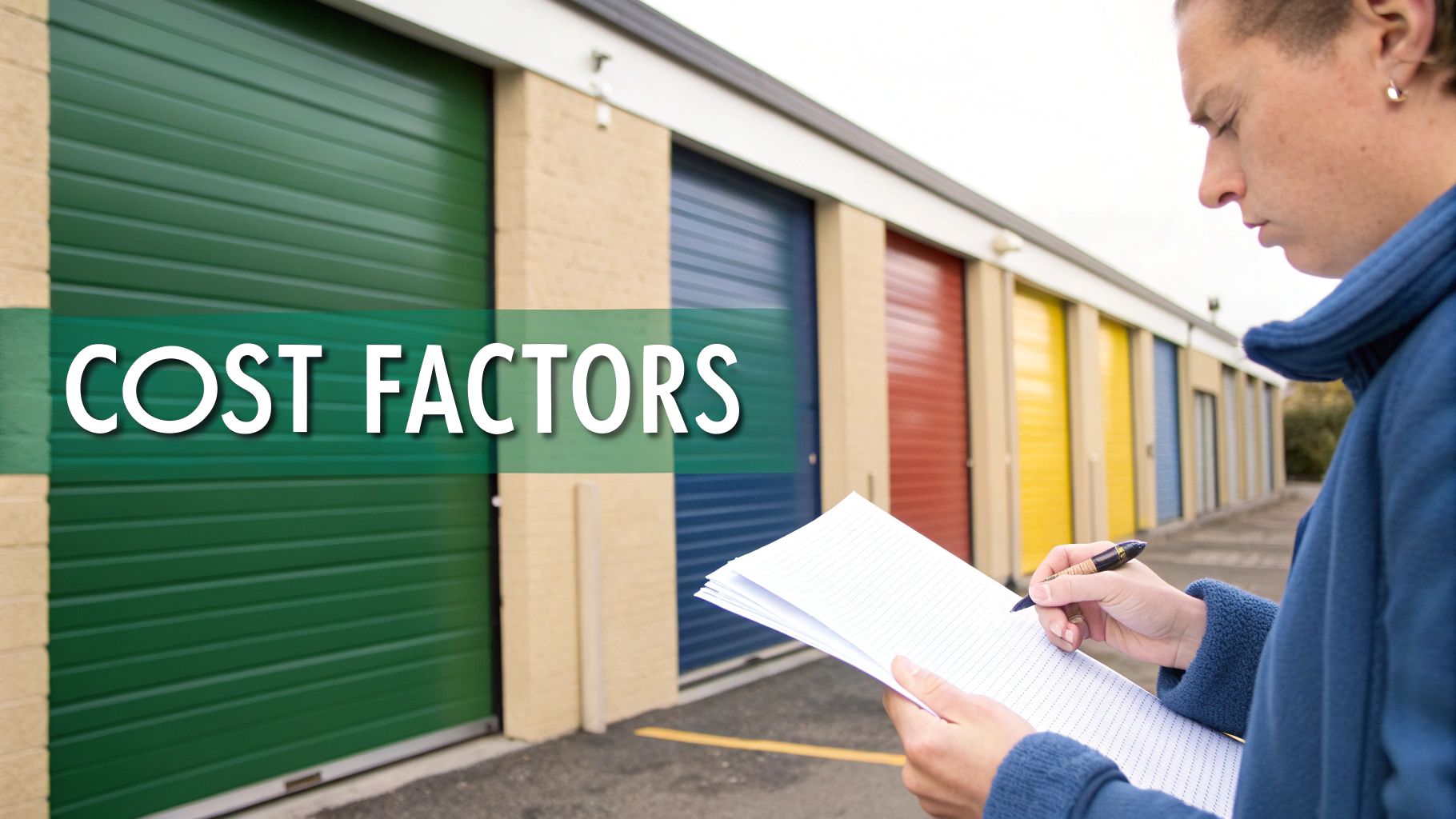
One of the quickest ways to waste money on storage is renting a unit that just doesn't fit your stuff. Paying for empty, unused space every month completely cancels out any effort you made to find a good deal with a storage unit cost comparison. The first step to a smart, cost-effective solution is getting an honest look at what you actually need to store.
It helps to think beyond simple dimensions. Instead of just picturing square footage, try to visualize your belongings in a familiar space. This simple mental shift can save you from underestimating and scrambling for more space at the last minute, or overestimating and throwing money away.
Matching Unit Size to Your Belongings
To avoid paying for air, it’s a good idea to connect standard unit sizes to real-world spaces. This little trick makes it much easier to guess how much room your things will take up once they're properly packed and stacked.
- 5x5 Unit (25 sq. ft.): Think of a large walk-in closet. This is perfect for stashing seasonal items, a few dozen boxes, small furniture like a desk or chair, or everything from a college dorm room.
- 10x10 Unit (100 sq. ft.): This is about the size of an average bedroom. It can usually hold the contents of a one-bedroom apartment, including big appliances, a mattress set, a sofa, and plenty of boxes.
- 10x20 Unit (200 sq. ft.): Picture a standard one-car garage. It’s big enough for everything from a two or three-bedroom house—large furniture, major appliances, and lots of boxes. You could also use it for vehicle storage.
A rookie mistake is forgetting to use vertical space. Most storage units have ceilings that are eight to ten feet high. Using sturdy, stackable boxes and shelving can dramatically increase how much a unit can hold, maybe even letting you rent a smaller, cheaper size.
Standard vs. Climate-Controlled Units
Once you've nailed down the right size, the next big decision is the type of unit. This choice really affects both your final cost and how well your belongings are protected. The main difference is between a standard unit and one with climate control.
A standard drive-up unit is super convenient for loading heavy items, but it also exposes your belongings to the full force of outdoor temperature and humidity changes. For tough items like patio furniture, tools, or a car, this is usually a great, budget-friendly option.
However, a climate-controlled unit is a must-have for protecting sensitive items. These units keep the temperature and humidity steady, preventing damage from extreme heat, cold, and moisture. If you’re storing things for a while, understanding this difference is critical. For those planning a longer stay, our guide has some valuable long-term storage tips to keep your valuables safe.
So, when is climate control an absolute necessity?
- Wooden or Leather Furniture: It stops wood from warping, cracking, and splitting due to temperature swings and prevents mildew on leather from humidity.
- Electronics and Media: It protects the delicate components inside computers, TVs, and stereos from moisture and extreme temperatures.
- Artwork and Photographs: This is your best defense against fading, discoloration, and materials breaking down over time.
- Important Documents and Books: It keeps paper from becoming brittle or growing mold.
Tossing these items into a standard unit is a gamble that can lead to permanent damage. The slightly higher monthly cost for climate control is really an insurance policy, protecting the value of your most important possessions and making it a smart investment in your overall storage plan.
Don't Get Fooled by Hidden Fees and Surprise Costs

That super-low monthly rate you see advertised online? It’s almost never the full picture. When you’re doing a real storage unit cost comparison, you have to dig deeper than that initial price. The reality is that a bunch of extra fees can—and often do—get tacked on, inflating your final bill way more than you expected.
Getting a handle on these common charges is the only way to create an accurate budget and dodge those frustrating financial surprises. Many first-time renters get caught off guard, but once you know what to look for, you can ask the right questions and figure out your true total cost before signing anything.
One-Time Admin and Setup Fees
Right out of the gate, most storage facilities will hit you with a one-time administrative fee. Sometimes they call it a setup or application fee, and it usually falls somewhere between $10 and $30. This covers their cost of doing the paperwork and getting you set up in their system. It's almost always non-negotiable, but you should definitely ask about it so it's not a shock on your first invoice.
On top of that, some places require a refundable security deposit, which works just like one for an apartment rental. It’s their protection in case of damage or missed payments. Make sure you get the exact conditions for getting that deposit back in full.
Another common upfront cost? The lock. To keep their security uniform, many facilities require you to buy their specific high-security cylinder lock. This can easily add another $15 to $25 to your initial layout.
Here’s a major difference you’ll see in storage models: Some services, like Endless Storage, go with an all-in pricing approach. The price you see is the price you pay. It completely cuts out the guesswork of adding up a handful of different fees, which really simplifies the whole process.
Recurring Costs That Aren't Your Rent
The biggest recurring charge you'll face, aside from the rent itself, is mandatory insurance. Nearly every facility requires it because their own policy only covers the building, not your actual belongings. You generally have two choices:
- Facility Insurance: The easiest option is to buy a policy directly from the storage provider. These plans are convenient and usually run between $10 and $25 per month, though coverage amounts can vary.
- Existing Policy: It's worth checking if your current homeowner's or renter's insurance already covers items in off-site storage. If it does, you can just show them proof of coverage and skip their plan.
It also pays to know what’s happening in the broader market. Since 2023, average self-storage rental prices have actually dropped by around 24%, a big swing from the high demand we saw during the pandemic. For example, a small 5x5 unit might now average $33.78 a month, while a 10x20 unit is closer to $128.84. This just shows how much pricing can shift with the economy, a trend you can explore more over at selfstorage.com.
What Happens If You're Late? Penalties and Fees
Life happens, but a late payment can get expensive fast. Storage facilities are notoriously strict about due dates, and late fees can be a flat $20 to $30 or a percentage of your monthly rent—whichever is more. If you're consistently late, they can even "overlock" your unit, which means you can't get in until you’ve paid up.
In a worst-case scenario, if you stop paying for a long time, the facility can auction off everything in your unit to cover their losses. You absolutely have to read the fine print in your agreement to understand their grace period, the exact late fee structure, and the lien process. Your best bet is to set up automatic payments to avoid all that stress and extra cost.
To see how all these different costs stack up against each other across various providers, take a look at our detailed guide to compare storage unit prices.
Comparing Costs of Top Storage Companies
Figuring out the true cost of a storage unit goes way beyond the advertised monthly rent. If you want the best deal, you have to dig a little deeper. We're talking about the total cost—everything from that base rate and mandatory insurance to one-time admin fees and the real value of those flashy promotions from big names like Public Storage, Extra Space Storage, and CubeSmart.
Looking at the big picture is key. Thinking about strategies for effective comparison can help, even if the product is different. The core idea is the same: you have to look past the shiny "First Month for $1" signs to understand what you'll actually be paying month after month.
Dissecting the Base Rental Rates
That sticker price is just your starting point. It’s almost always driven by location and what the local demand looks like. Companies with a huge national presence, like Public Storage and Extra Space Storage, can have wildly different prices from one town to the next. CubeSmart, while also a major player, often gets more aggressive with its pricing in markets where it’s looking to expand.
To see just how much location shifts the price, take a look at the cost differences between city, suburban, and rural storage units.
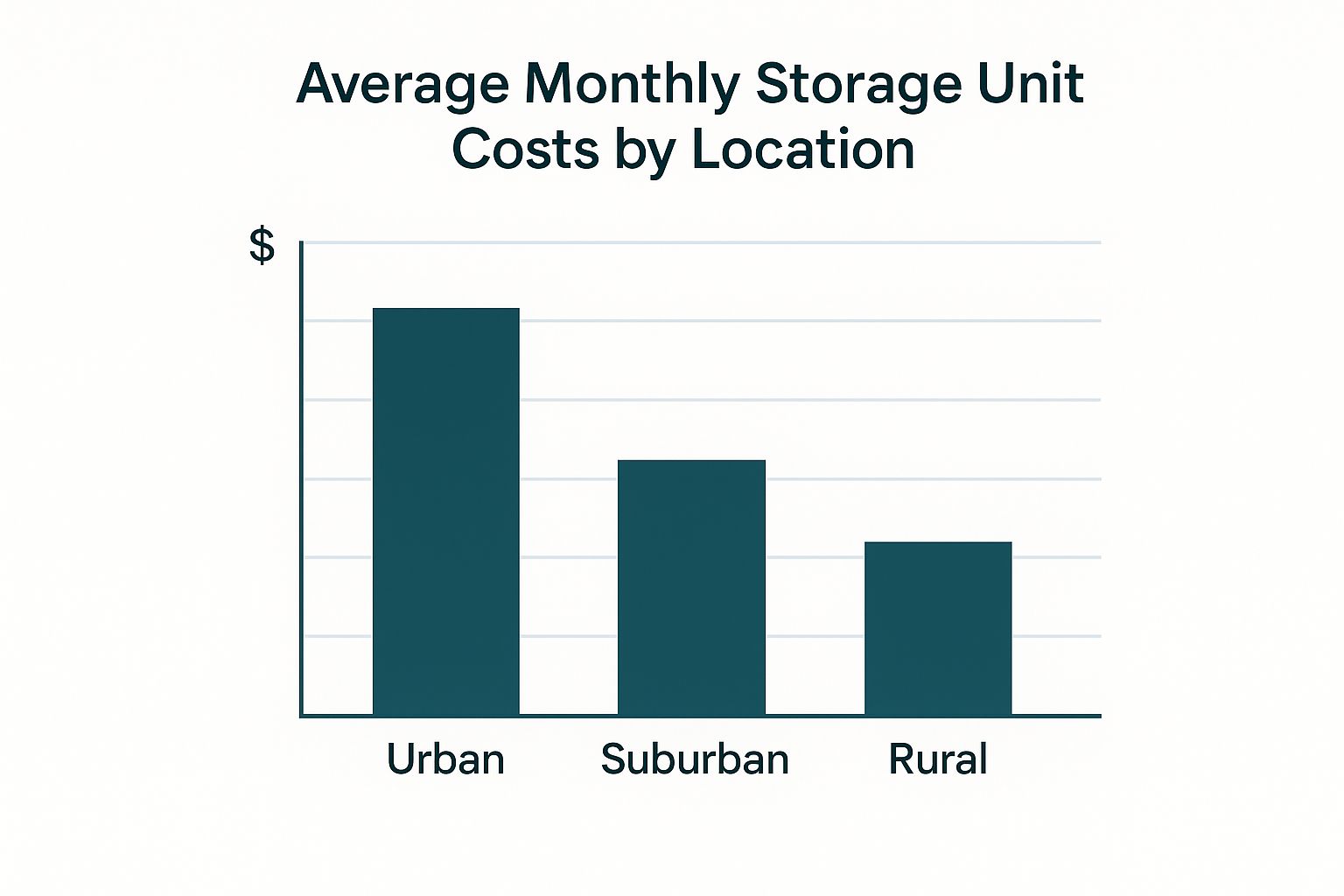
As you can see, renting in a packed urban center will always cost more. A quick drive out to the suburbs can save you a surprising amount of money. This is something you absolutely have to factor into your comparison.
Key Insight: Don’t just compare brands; compare specific locations. A Public Storage downtown might be way more expensive than a CubeSmart a few miles away. Always get quotes from multiple facilities for each company you're considering.
The Real Story on Fees and Insurance
This is where the hidden costs live. Almost every traditional storage company will hit you with a one-time administrative fee, usually between $20 and $30, just to get you set up. On top of that, you'll be required to have insurance, which adds another monthly charge to your bill.
Let's break down how these costs usually stack up with the big three providers. This will give you a much clearer picture of your real monthly expense, not just the advertised rate.
Head-to-Head Storage Provider Cost Comparison
Here’s a detailed breakdown of pricing, fees, and insurance costs across leading self-storage companies to reveal the true monthly expense.
The table makes it pretty clear. That "$1 First Month" from Public Storage sounds incredible, but don't forget to add in the admin fee and the ongoing insurance. Similarly, Extra Space Storage might offer a free month, but their insurance costs have a much wider range and could make them pricier over a six-month rental. CubeSmart often comes in as a slightly more budget-friendly option, but you have to read the fine print on their deals.
If you want to learn more about what to expect from different kinds of places, our guide on understanding storage unit facilities has some great extra context.
Evaluating the Value of Promotions
Promotions are designed to get you in the door, but they don't last forever. The most common deals, like a free or heavily discounted first month, are great marketing—but whether they're a great deal for you depends on your situation.
- Short-Term Storage (1-3 months): A "First Month Free" offer is a huge win here. It can cut your total cost by a third, making it a fantastic deal if you just need space for a little while.
- Long-Term Storage (6+ months): If you're planning to stay longer, that intro offer starts to mean a lot less. The standard monthly rate and insurance costs become the most important numbers for your budget. A company with a slightly higher upfront cost but a lower standard rate could easily be the cheaper choice in the long run.
Ultimately, choosing the right provider means balancing all these different costs against what you actually need. The best deal isn't always the one with the lowest price tag on day one—it's the one that gives you the most predictable and affordable total cost over your entire stay.
Traditional vs. Portable Storage Cost Analysis
When you start looking at storage options, you’ll quickly see the market is really split in two: the old-school self-storage facility and the newer portable storage containers. They operate on completely different pricing models, which can make a straight-up comparison feel like comparing apples and oranges. The best choice really boils down to your specific project, whether you're moving, decluttering, or just need some extra space long-term.
A traditional facility gives you a fixed space at a set location that you rent monthly. Portable containers, on the other hand, bring the storage right to your driveway. This creates a flexible solution that can totally eliminate the hassle of renting a truck and loading and unloading your stuff multiple times. That fundamental difference is the real key to understanding where each one offers the best value.
The True Cost of Convenience
The biggest thing separating these two is convenience, and that has a direct impact on your total cost and effort. With a traditional storage unit, all the logistics are on you. That means you’re on the hook for:
- Transportation: Renting a moving truck or van to haul everything to the facility.
- Labor: Loading the truck at your house, driving it over, unloading it into the unit, and doing it all over again when you want your things back.
- Time: This process can eat up an entire weekend, especially for a bigger move.
Portable storage, like the service you’d get from PODS or U-Pack, flips this model on its head. They drop off a container, you load it on your own schedule, and then they handle all the driving, either to a secure facility or to your new home. While the monthly container fee might look higher at first, it often shakes out to be cheaper once you add up what you save on truck rentals, gas, and mileage fees.
Unpacking the Pricing Models
You have to get how each service charges to make an informed choice. Traditional facilities mostly just charge a monthly rent based on the unit’s size and if it has climate control. Portable storage is a bit more layered.
Traditional Storage Cost Factors:
- Monthly rent for the unit itself
- A one-time administrative fee
- Mandatory monthly insurance
- Cost of a required lock
Portable Storage Cost Factors:
- Initial delivery fee for the container
- Monthly rental fee while you have it
- Transportation fee (if you're moving it to a new address)
- Final pick-up and return fee
Portable storage provides a powerful advantage for anyone in the middle of a move. You load your items once and unload them once at your destination. This single-handling approach not only saves significant physical effort but also reduces the risk of damaging your belongings during transit.
Situational Cost Breakdown
Which option is cheaper really depends on what you're doing. Let's walk through a couple of common scenarios to see how the costs actually play out.
Scenario 1: Long-Term Local Storage
If you just need to store holiday decorations or extra business inventory for six months or more and think you'll need to get to it often, a traditional self-storage unit is almost always the more cost-effective choice. The delivery and pickup fees for portable storage can add up, making it less than ideal for static, long-term situations where you aren’t planning a move.
Scenario 2: Home Renovation or Moving
For a local move or during a big home renovation project, portable storage often wins on both cost and convenience. The container acts as on-site storage, so you don't have to rent a truck. When you’re ready, the company moves it for you, combining your moving and storage costs into one simple expense. Skipping the truck rental and all that extra labor can easily make up for the higher monthly rate.
In the end, your decision comes down to calculating the total cost. This isn’t just the rent, but also the insurance, fees, and the value of your own time and effort. To get a full picture of all the potential expenses, it’s a good idea to learn about the typical cost of storage unit insurance and other common fees before you sign on the dotted line.
Answering Your Top Storage Cost Questions
Even after you've crunched the numbers and done a thorough storage unit cost comparison, a few questions always seem to pop up. This is where we tackle those nagging uncertainties head-on, giving you straight, simple answers to the most common questions people have about storage pricing.
Think of it as the last piece of the puzzle. We want you to feel completely confident before you rent, so we’ll get into the details that really make a difference, from how your location impacts price to whether you actually need the facility’s insurance.
Is It Cheaper to Rent a Unit in a Rural or Urban Area?
Yes, almost without exception, you'll find it's significantly cheaper to rent a storage unit in a suburban or rural spot compared to a busy city. It all comes down to basic real estate economics.
Facilities in cities are dealing with sky-high property values, steeper taxes, and bigger operating costs. Naturally, those expenses get passed on to you. On top of that, city living often means smaller apartments and condos, creating a constant demand for extra space that keeps prices high.
You can often save a surprising amount of money just by driving 15 to 30 minutes out of the city. You might even discover you can get a much larger unit for what a tiny one would cost you downtown. The trade-off, of course, is the time and fuel it takes to get to your stuff.
Expert Tip: If you only need to get to your belongings once in a while, the savings from a suburban facility are tough to ignore. But if you’ll be in and out of your unit frequently, the convenience of a closer (though pricier) option might be the smarter choice.
Do I Really Need to Buy the Facility's Insurance?
Here’s a critical point that many renters miss: while virtually every storage facility requires you to have insurance, you're not always forced to buy their policy. Understanding this can save you real money every month.
Before you agree to the facility's in-house plan, do these two things first:
- Check Your Existing Policies: Your first call should be to your current homeowner's or renter's insurance provider. Many policies already cover personal items stored off-site. The key is to confirm the coverage limits and make sure they’re high enough to protect the value of what you’re storing.
- Compare Third-Party Options: If your current policy falls short, it's time to shop around. Look into specialized third-party storage insurance providers and compare their plans against what the facility is offering. You can sometimes find better coverage for a lower price.
Whatever you do, don't go without insurance. The rental agreement you'll sign almost certainly states the facility isn't liable for things like theft, fire, or water damage. That insurance is there to protect you, not them.
How Can I Find the Best Deals on Storage Units?
Getting the best deal on storage takes a little bit of smart searching, but the savings are well worth it. The trick is to look past the first price you're quoted and be a little flexible.
Start your hunt on online storage marketplaces. These websites are fantastic for running a quick storage unit cost comparison across your entire area, letting you see what multiple companies are charging all in one place.
Keep an eye out for big promotions like "First Month Free" or "50% Off" the first couple of months. Just make sure to read the fine print—these deals usually require you to stay for at least two or three months to qualify.
Insider Tip: Don't hesitate to pick up the phone. Call a few facilities directly and just ask if they have any specials that aren't advertised online. You’d be surprised what kind of discounts they might offer for students, military personnel, or long-term renters.
Finally, think about your timing. The storage business is seasonal, with demand hitting its peak during the summer moving rush. If you can hold off and rent in the fall or winter, you'll often find lower base rates and more aggressive promotions as facilities try to fill up their empty units.
Ready to skip the hidden fees and logistical headaches of traditional storage? Endless Storage offers a simple, transparent solution with by-the-box storage delivered right to your door. Get a clear, all-in price and manage everything online. Start storing the smart way with Endless Storage today.
Frequently Asked Questions
Unveiling the Secrets to Effortless Storage
Endless Storage is available nationwide. You pick a plan, tell us where to pickup, and we'll send a UPS van to collect, whichever state you're in.
Your shipping label will be sent to your email within a few minutes, if not instantaneously. It can also be accessed through your customer profile.
Your box will be shipped to one of our climate controlled self storage facilities in our closest self storage facility. Our manager will accept your package, notify you that your box has been received, and securely stored. Only our managers will have access to Endless Storage boxes.
Email us at admin@endless-storage.com click to live chat with us, or send us a message below.
Never! We're committed to transparent pricing with no surprises. You'll lock in your rate with no hidden fees and no long-term contracts.
Fast access guaranteed! Your boxes will arrive at your doorstep within 48 hours of requesting them back. Need to check on delivery? We provide tracking information for complete peace of mind.
Totally flexible! Store month-to-month with no long-term commitment and cancel anytime.
Everything's online! Use your account dashboard to:
• Set up automatic monthly payments
• Request box returns
• Update your address
• Order additional boxes
• Track shipments
Your boxes are insured up to $100 each. Our customer service team will help you file any necessary claims and resolve issues quickly.
Don't worry – we'll email you right away if there's a payment issue. Your items stay safe, though you may have temporary service interruption or late fees until payment is resolved.
When you request our free storage kits, you'll have 30 days to send in your boxes to activate your 3 months of free storage. Think of it like starting a gym membership – your activation window begins when you receive your kits, and your full free trial begins once you send in your first box. During your free months, you'll experience our complete storage service at no cost.
Your 30-day activation window begins when you receive your storage kits. We'll send you an email confirmation when your kits are delivered, marking the start of your activation period.
If you haven't sent any boxes for storage within your 30-day activation window, your free trial will expire and we'll begin charging the regular monthly rate of $9.99 per box. This helps ensure our storage kits go to customers who are ready to use our service.
A box costs $9.99 per month to store (plus sales tax). This price includes free shipping for standard boxes under 50 lbs. and smaller than 16"x16"x16"
Log into your Endless Storage account, locate the box you would like returned, and simply click Return My Box.
Yes, each box stored with us is insured for up to $100 throughout transit as well as the duration of storage within our facilities.
Your box will be at your doorstep within 48 hours of you requesting it back.
Store 10+ boxes? We'll pick them up for free! After your purchase, we'll contact you to schedule a convenient pickup time and arrange UPS collection.
We trust UPS with all shipments, and every box includes $100 insurance coverage. You'll receive tracking information to monitor your items' journey.
Yes! Visit any of our locations by appointment. Just bring a photo ID matching your customer profile.
For everyone's safety, we can't store hazardous materials, firearms, or perishables. All items must fit within our standard boxes.
It's easy! Order your storage kit online, and we'll ship it to you within 1-2 business days. Your shipping labels will be emailed instantly and available in your account.
We're here to help! Email us at admin@endless-storage.com, use our live chat, or send us a message through your account.
To cancel your storage service with Endless Storage, please email your cancellation request to admin@endless-storage.com. Our team will process your request within 2 business days and confirm your cancellation via email.
We understand packing takes time. However, to maintain your free trial benefits, you'll need to send at least one box within the 30-day activation window. If you need more time, you can always start with one box to activate your trial and send the rest later. You can always reach out to admin@endless-storage.com if you have any issues or concerns.
When you request our free storage kits, you're starting a 30-day window to begin using our storage service.
To avoid any charges, simply send at least one box for storage within 30 days to activate your 3-month free trial. If you decide not to use our service and don't send any boxes within the 30-day window, a one-time $50 fee will apply to cover the costs of materials and shipping. This helps ensure our storage kits go to customers who are ready to use our service.
Think of it like reserving a hotel room – we're setting aside space and sending specialized packing materials for your use. The fee only applies if you request materials but don't begin storage, similar to a hotel's no-show charge.
